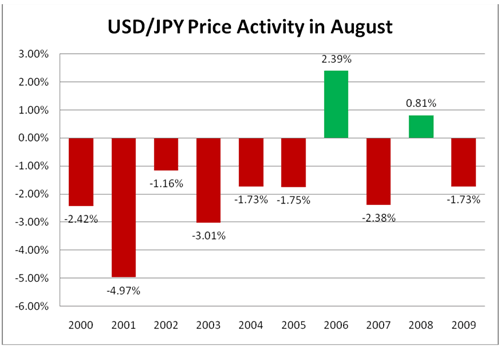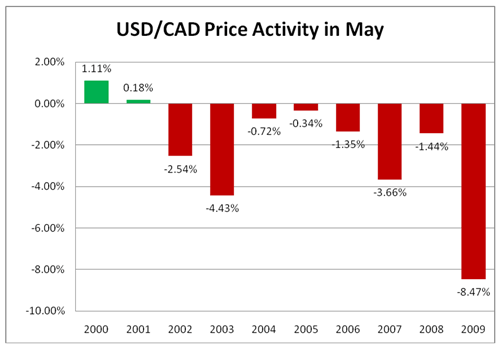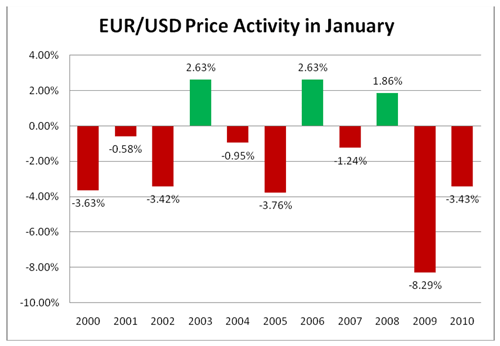When it comes to trading the currency market, you may often find yourself making one of two choices: pro-dollar or anti-dollar. As a component of more than 85% of all currency transactions, the U.S. dollar has long been the primary driver of fluctuations in exchange rates. Most traders will analyze the future direction of the dollar by using either fundamental or technical analysis or a combination of both. However, few people realize that the time of the year could also play a role in how the U.S. dollar behaves against various currencies. The study of technical analysis is about analyzing past price activity through the use of indicators. There are many ways to do this with a laundry list of technical indicators to help you look at price in different ways.
Filtering Out NoiseMost traders may not realize that there is no clearer way to analyze past price behavior than to look at the price activity itself without the noise of indicators. When you look purely at price, you may notice patterns known as seasonality. Seasonality is a predictable change that repeats every year at the same period in time. For example, you may not have realized that in eight out of the past 10 years (between 2000 and 2009), the U.S. dollar fell in the month of May against the Canadian dollar. Or that in eight out of the past 10 years, the U.S. dollar fell against the Japanese yen in the month of August. There are no guarantees that historical patterns will repeat themselves but whenever a pattern has been repeated 80-90% of the time, it becomes statistically significant – and that can be very valuable information when you are trading. In this article, we will talk about why seasonality is an important concept in the forex market and why it should not be ignored. (For related reading, see Capitalizing On Seasonal Effects)
July: A Positive Month for USD/JPY One of the strongest examples of seasonality is the one in USD/JPY, which can be seen in Figure 1 below. In 80% of the samples (or eight out of the past 10 years), USD/JPY ended the month of July higher than where it started. It is difficult to pinpoint an exact reason for why USD/JPY tends to behave this way in the month of July, although it could be related to the end of the first quarter in Japan or the beginning of the second half of the year in the U.S.. Either way, this instance of seasonality is very strong and one that is worth keeping in mind if you find some short USD/JPY trades during the month of July. The presence of seasonality may encourage you to take a smaller-than-usual short position or to avoid longer term short USD/JPY trades during this period.
 August: USD/JPY Gains Made in July Are Often Erased
August: USD/JPY Gains Made in July Are Often Erased There is also a strong case of seasonality in USD/JPY during the month of August. As you can see in Figure 2, below, a good portion of the gains earned in July were erased in August. In fact, a look at other yen crosses quickly reveals that in a calendar year August tends to be the strongest month for the Japanese yen across the board. In other words, other currencies such as the U.S. dollar, euro and British pound have a strong tendency to fall against the yen in August.
 May: A Very Negative Month for the USD/CAD
May: A Very Negative Month for the USD/CAD For USD/CAD, the strongest case of seasonality is in the month of May. In eight out of the last 10 years (between 2000 and 2009), the Canadian dollar rallied against the U.S. dollar that month. The only explanation for this price pattern is the seasonality in oil prices. Canada is one of the world's largest oil producers and therefore Canadian companies tend to be very sensitive to the price of oil. The tendency for oil prices to rise during March and April could have boosted the profitability of Canadian companies, leading to seasonal improvements in economic data.
 January: A Negative Month for EUR/USD
January: A Negative Month for EUR/USD Cases of seasonality can also be found in other currency pairs such as the EUR/USD and the NZD/USD. The behavior of the U.S. dollar against the euro in the month of January, for example, shows strong seasonality. In seven out of the past 10 years, the U.S. dollar rallied in the month of January. The reason that we typically see this behavior is because many companies and funds tend to repatriate their money back to their local country at the end of the year to dress up their balance sheets. In the beginning of the year, money is once again sent abroad for new investment purposes. Because everyone starts with a blank slate as far as profits and losses go, their main focus is to initiate new positions. The U.S. market is one of the most liquid markets in the world, which explains why a lot of that investment money ends up there. In the case of the NZD/USD, the currency pair has risen eight out of the past 10 years in the month of December.
 Implications for Traders
Implications for Traders As traders, there are many ways that you can apply the knowledge of seasonality to improve your trading. For example, if you are trading the GBP/USD in the month of September, as a longer term trader you can look for opportunities using fundamentals or technicals to buy the GBP/USD or to go in the direction of the seasonal trend. As a shorter term trader, you can reduce your holding period if you are taking a trade that is against the seasonal trend or, like longer term traders, you can focus on primarily looking for long GBP/USD trades. Although seasonal patterns do not duplicate themselves 100% of the time, following seasonality rather than fading it may improve your ability to find high probability trades.
Conclusion Although instances of seasonality in the forex market are rare, being aware of them can help traders become more in-tune with the outlook for their currency trades. Seasonal patterns won't always be repeated as the data suggests,but being aware of the trends can help forex traders understand where the probabilities lie. If there is a strong case of seasonality in a given month, it may help to support a trade idea or provide a reason to avoid it.